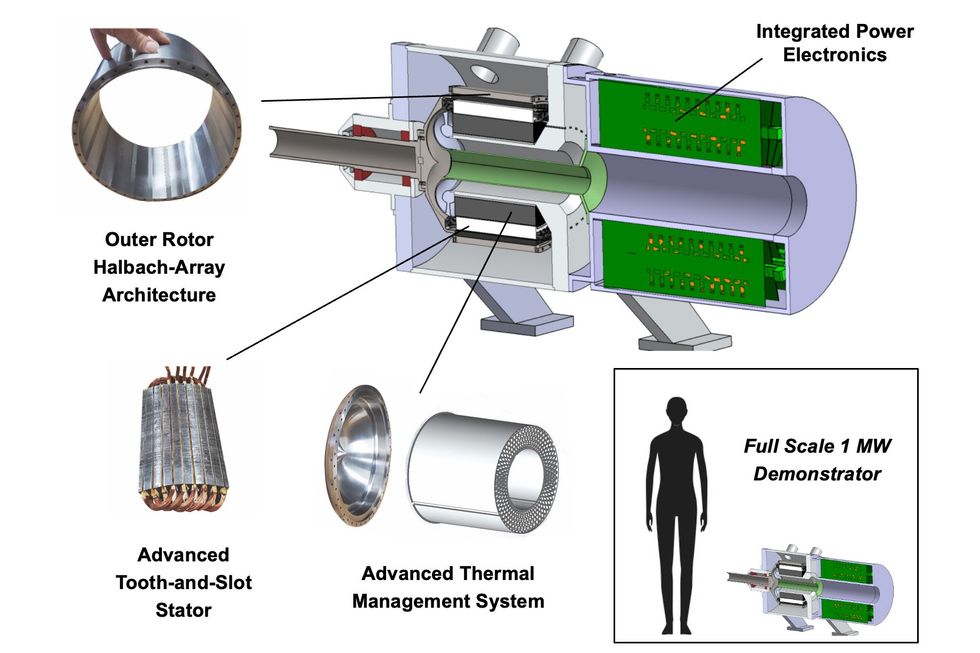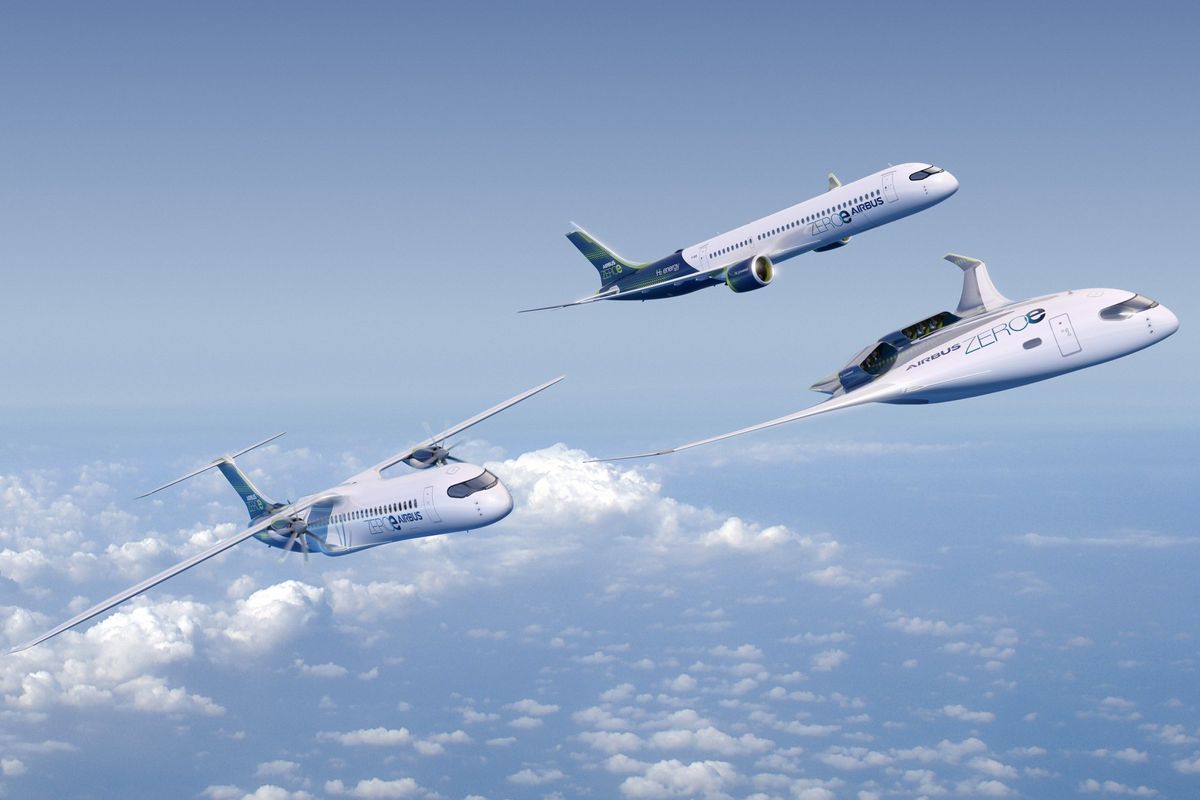Aviation aims to slash some of its substantial carbon emissions by electrifying aircraft, but the industry’s stringent weight restrictions make this difficult. Building electric motors that match the power-to-weight ratios of jet engines has proven especially challenging, so most efforts have been restricted to smaller aircraft. A new compact lightweight design for a megawatt-scale motor unveiled by researchers at MIT could open the door to electrifying much larger aircraft.
While the automotive sector is undergoing a transition from fossil fuels to battery power, doing the same in aviation is much harder. The energy density of modern batteries is still far too low to power aircraft for substantial distances, which is why companies like Eviation are focused on short intercity hops and a host of EVTOL companies are aiming to disrupt the daily commute.
“There is no silver bullet when it comes to achieving the required paradigm shift in specific power. Many things together make the design possible, and the devil is in the details.”
—Zoltán Spakovszky, MIT
Batteries may get most of the attention, but they’re not the only place where weight is a problem—electrifying the motors has also been a challenge. Electric motors create thrust by passing current through large amounts of copper wiring and steel to create magnetic fields that can turn a rotor. These materials are inherently heavy, says Zoltán Spakovszky, a professor of aeronautics at MIT, which makes it difficult to build electric motors with a high power-to-weight ratio, also known as specific power. That’s because making motors more powerful means adding a lot more metal.
As a result, the motors used in current electric aircraft are capable of producing only hundreds of kilowatts of power, which is too little to power larger aircraft. But in research presented at the AIAA AVIATION Forum, held between 12 and 16 June in San Diego, Spakovszky and his colleagues unveiled designs for an electric motor capable of generating 1 megawatt of power. They say the achievement will bring the electrification of regional jets within reach.
“The majority of CO2 is produced by twin and single-aisle aircraft which require large amounts of power and onboard energy, thus megawatt-class electrical machines are needed to power commercial airliners,” says Spakovszky. “Realizing such machines at 1 MW is a key stepping stone to larger machines and power levels.”
The team’s design features a circular drum—the rotor—with an interior surface lined with permanent magnets. Sitting inside the rotor is a stator—a cylindrical piece of steel with an outer surface covered in protruding “teeth.” These teeth are covered in densely coiled copper wires. Passing a current through these wires generates a strong magnetic field, which interacts with the permanent magnets on the rotor to spin the drum around and drive the motor.
The MIT team has yet to assemble their device, but they have tested all of the major components and demonstrated in simulation that it will be able to reach the expected power levels. When fully assembled, the motor will weigh 57.4 kilograms, which equates to a specific power of 17 kilowatts per kilogram, considerably more than the 13 kW/kg that previous research from NASA identified as necessary to power large electric aircraft.

Getting there wasn’t simple, says Spakovszky. “There is no silver bullet when it comes to achieving the required paradigm shift in specific power,” he says. “Many things together make the design possible, and the devil is in the details.”
Normally, rotors include a layer of heavy steel that helps concentrate the magnetic fields of the permanent magnets. The team managed to achieve the same effect by carefully arranging the magnets in different orientations, allowing them to replace the steel with a much lighter titanium drum.
The design also features an incredibly compact stator design that improves electrical efficiency and a high-speed power electronics system made from 30 custom-built circuit boards. The boards make it possible to alternate the currents in the stators at an incredibly high frequency and therefore significantly increase the speed at which the motor rotates.
One of the most critical elements is the way the team dealt with thermal management. Producing 1 MW of power generates roughly 50 kilowatts of heat, says Spakovszky. “Think of a car engine revving at full power and turning all the work into heat,” he says. “Or consider 500 incandescent 100-watt lightbulbs burning inside the space equivalent to a small beer keg.”
The MIT team’s design features a novel air-cooled heat exchanger made from aluminum alloy that sits inside the stator. The cylindrical structure features a honeycomb of small air channels, whose complex geometry means it has to be 3D printed. But the design enables the team to achieve cooling efficiency close to what you would get with a liquid system, says Spakovszky, while maintaining the required structural integrity.
“It’s great to see the progress being made by MIT,” says Kiruba Haran, a professor of electrical and computer engineering at the University of Illinois Urbana-Champaign. “They have a great team and are taking a good multidisciplinary approach. That’s the only way to do this.”
MIT isn’t the only institution developing a megawatt-scale electric motor. NASA has been championing efforts to build high-power electric motors through its Advanced Air Transport Technology programs since 2014, funding Haran’s University of Illinois group, as well as groups from Ohio State University and the University Of Wisconsin–Madison.
Both the Ohio and Illinois teams have tested working prototype megawatt-scale motors. Last year, engineering giant GE announced it had tested a megawatt-scale propulsion system in conditions that simulate real flight. Haran’s group is now in the process of trying to commercialize their motor through a spinout called Hinetics.
Megawatt-scale electric motors could have an impact on aviation relatively soon, says Haran, even if battery technology takes time to catch up. Fossil-fuel alternatives like hydrogen and ammonia are likely to rely on fuel cells that convert chemical energy to electrical energy, and will therefore require electric propulsion systems. And hybrid systems, in which electric motors are integrated with gas turbines to allow battery-powered operation for parts of the flight, could come even sooner, says Haran.
Electric motors will also be key to enabling more unusual and efficient aircraft configurations such as distributed propulsion, says Spakovszky. The idea would be to replace the large jet engines slung under the wings with many smaller electric motors arranged across the leading edge of the wings or even on the fuselage.
“I believe, that to achieve net-zero emissions, future aircraft will have to look different, and megawatt-class electrical machines are key enablers for unconventional aircraft configurations,” says Spakovszky.
This article appears in the September 2023 print issue as “Aircraft Motor Breaks the Megawatt Barrier.”
- Maxwell, NASA’s e-Plane, Is Running Out of Runway ›
- With Ultralight Lithium-Sulfur Batteries, Electric Airplanes Could Finally Take Off ›
- Who Will Free EV Motors from the Rare Earth Monopoly? - IEEE Spectrum ›
- Donut Lab's New Motor Brings Power to the Wheel Hub - IEEE Spectrum ›
- Airbus Plans Fuel-Cell Powered, Electric Aircraft - IEEE Spectrum ›
- Electric Aircraft Motor Gets Superconducting Upgrade - IEEE Spectrum ›
Edd Gent is a freelance science and technology writer based in Bengaluru, India. His writing focuses on emerging technologies across computing, engineering, energy and bioscience. He's on Twitter at @EddytheGent and email at edd dot gent at outlook dot com. His PGP fingerprint is ABB8 6BB3 3E69 C4A7 EC91 611B 5C12 193D 5DFC C01B. His public key is here. DM for Signal info.



